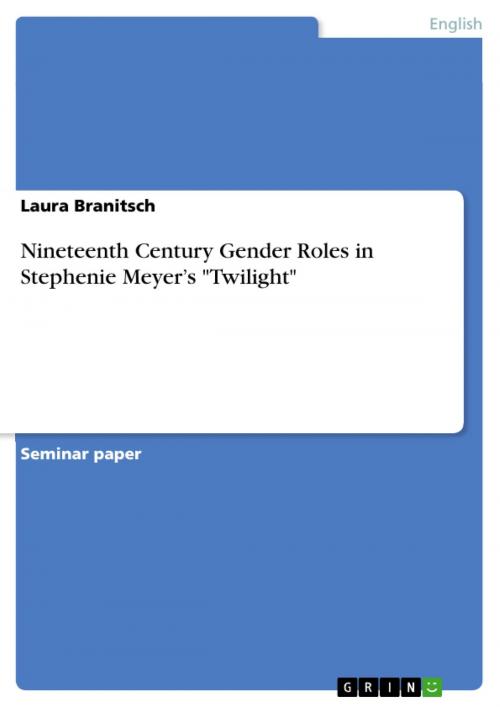Nineteenth Century Gender Roles in Stephenie Meyer's 'Twilight'
Nonfiction, Entertainment, Drama, Anthologies| Author: | Laura Branitsch | ISBN: | 9783668255319 |
| Publisher: | GRIN Publishing | Publication: | July 7, 2016 |
| Imprint: | GRIN Publishing | Language: | English |
| Author: | Laura Branitsch |
| ISBN: | 9783668255319 |
| Publisher: | GRIN Publishing |
| Publication: | July 7, 2016 |
| Imprint: | GRIN Publishing |
| Language: | English |
Seminar paper from the year 2015 in the subject American Studies - Literature, grade: 1,3, , course: Values and Visions in American Literature, language: English, abstract: Upon its release in 2005, the novel 'Twilight' by Stephenie Meyer became an instant success. The success of 'Twilight' is undeniable, but the reason of why it became so popular is debatable. Besides the obvious success, the series has gotten copious amounts of criticism from the day of its release, most regularly from self-proclaimed feminists for the gender representations exhibited in the books and for the relationship standards set out by Meyer. Jost expresses his disappointment that Meyer has created a story that 'had the potential to be 'a provocative piece of gothic fantasy', but then marred it through the creation of unlikeable, anti-feminist characters and an anachronistic setting which forces modern readers into the mindset of a previous time'. In this essay, this connection to the above-mentioned 'previous time' shall be made clearer by comparing the gender roles displayed in 'Twilight' to those of the early nineteenth century. In order to first gain an understanding of the way the perception of the differences between the sexes has changed in the course of the past two centuries, I will outline the gender roles of the nineteenth century and then briefly summarize what achievements have been made to erase these stereotypes in chapter 2. Next, in chapter 3, the respective personalities of the two protagonists, Edward and Bella, shall be separately analyzed and compared to the qualities of the ideal men and women in the early eighteen hundreds. In chapter 4, I will address the respective relationship roles of the couple, again pointing out the similarities to what a marriage was supposed to be like in the early nineteenth century. Since the saga puts a vast emphasis on the romance between the two protagonists, it is crucial to understand it properly. The results of my analyses should answer the question of whether the two protagonist's character traits and their relationship really correspond more to early nineteenth century standards than to the modern ones. I hope to gain an understanding of how and especially why the relationship between Edward and Bella works, and expect to find an answer in their character traits. The historical context, which will be discussed in the next chapter, might give me an insight into their motivations and their personalities as compared to what was expected of men and women in the past.
Seminar paper from the year 2015 in the subject American Studies - Literature, grade: 1,3, , course: Values and Visions in American Literature, language: English, abstract: Upon its release in 2005, the novel 'Twilight' by Stephenie Meyer became an instant success. The success of 'Twilight' is undeniable, but the reason of why it became so popular is debatable. Besides the obvious success, the series has gotten copious amounts of criticism from the day of its release, most regularly from self-proclaimed feminists for the gender representations exhibited in the books and for the relationship standards set out by Meyer. Jost expresses his disappointment that Meyer has created a story that 'had the potential to be 'a provocative piece of gothic fantasy', but then marred it through the creation of unlikeable, anti-feminist characters and an anachronistic setting which forces modern readers into the mindset of a previous time'. In this essay, this connection to the above-mentioned 'previous time' shall be made clearer by comparing the gender roles displayed in 'Twilight' to those of the early nineteenth century. In order to first gain an understanding of the way the perception of the differences between the sexes has changed in the course of the past two centuries, I will outline the gender roles of the nineteenth century and then briefly summarize what achievements have been made to erase these stereotypes in chapter 2. Next, in chapter 3, the respective personalities of the two protagonists, Edward and Bella, shall be separately analyzed and compared to the qualities of the ideal men and women in the early eighteen hundreds. In chapter 4, I will address the respective relationship roles of the couple, again pointing out the similarities to what a marriage was supposed to be like in the early nineteenth century. Since the saga puts a vast emphasis on the romance between the two protagonists, it is crucial to understand it properly. The results of my analyses should answer the question of whether the two protagonist's character traits and their relationship really correspond more to early nineteenth century standards than to the modern ones. I hope to gain an understanding of how and especially why the relationship between Edward and Bella works, and expect to find an answer in their character traits. The historical context, which will be discussed in the next chapter, might give me an insight into their motivations and their personalities as compared to what was expected of men and women in the past.















